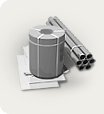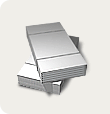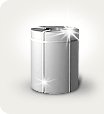The final stage of work for any enterprise for the production of bulk materials is to obtain a marketable product of the appropriate fractional composition. In this case, the mechanization of the technological process is based on screens - special sieves or grids through which the source material is sieved. The required fineness is achieved depending on the mesh size. Screening can be done dry or wet.
Principle of Dry Vibrating Screen
Sorting equipment of this type consists of several main parts - a box with one or more screens, a vibration initiator, support springs or special hangers. The separation process takes place in the following order:
- Bulk material is loaded into the receiving box.
- An electric motor eccentrically connected to the working surfaces of the machine sets them in motion.
- Under the action of vibration, the substance is distributed throughout the box and sifted through the cells.
- Once on the lower tier, the operation is repeated.
- Large particles remain at the appropriate level.
- The final product is being extracted and packaged.
The degree of cleaning depends on the number of sieves. Vibrating screens are simple in design and have lower energy consumption compared to wet screening equipment.
How the hydraulic screen works
The basis of the wet method of separation of bulk materials is the extraction of fine fractions from the pulp, which is an aqueous solution of the original rock.
There are three main types of hydraulic screens, in accordance with the type of screening plane used. These are installations with an immovable screening surface, with limited movable grids and with screens partially immersed in the pulp.
The grids and sieves themselves can be flat or made in the form of curved surfaces around the circumference. Separation into fractions is carried out due to the high initial speed of the pulp entering the inclined sieve or vibration of the grate itself.
On hydraulic screens used to obtain fractions less than 0.5 mm, an additional shaking mechanism is mounted, which makes it easier to clean the cells.






